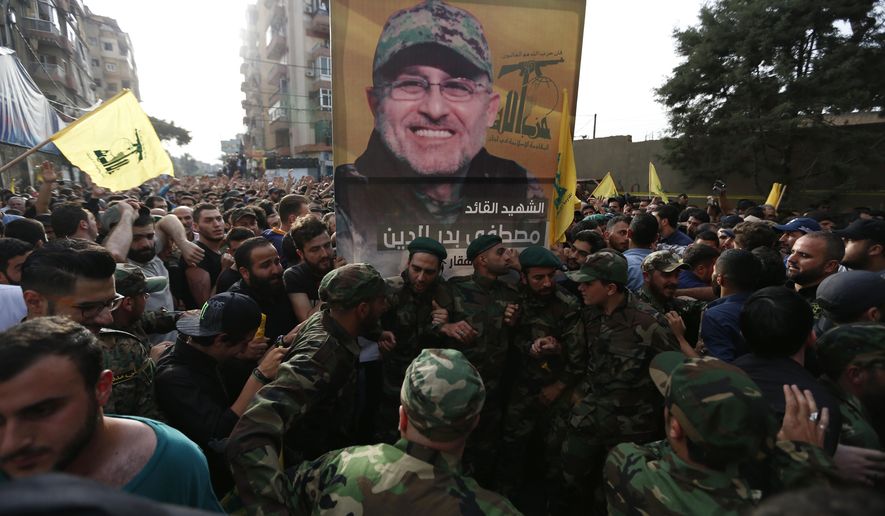ISTANBUL — The Lebanese Shiite militia Hezbollah and the Syrian government have enjoyed a close, fruitful relationship for nearly 40 years. But six years into the Syrian civil war, there are signs that battle fatigue and diverging strategic visions are fraying their alliance.
Syrian President Bashar Assad is coming under increasing pressure from pro-Russian factions in his ruling circle to dump pro-Iranian Hezbollah, as a U.S.-Russia accord to establish a de-escalation zone in southern Syria gets underway this week.
It’s a different kind of proxy war playing out in Syria: Instead of Sunni versus Shiite, or the U.S. versus Russia, it’s Russia versus Iran.
“There is a pro-Moscow faction that wants Syria to be secular and includes officers who trained in Russia,” said Ayman Abdel Nour, publisher of the largest anti-Assad Syrian news portal and leader of the country’s exiled Christian community based in Dubai, United Arab Emirates. “Those who support Iran are people bought by the Iranians or [who] reached their positions of power with Iranian help.”
Incidents of rivalry and strain between Hezbollah forces and Syrian government allies have been increasing since June 2016, when they openly clashed during what was supposed to be a joint operation in the Aleppo countryside.
Hezbollah has balked at implementing Russian-brokered cease-fire agreements, such as one in December in Aleppo, and occasional firefights have broken out between the two forces in the northwestern suburbs of Damascus on the road from the capital to Beirut.
Meanwhile, the Russian Defense Ministry has ordered aerial bombings of Shiite militia positions when Iran-backed forces interfered with plans to evacuate civilians to safe areas.
“The Hezbollah message has been: ’Don’t think you can make a deal without us. We are on the ground, and we control what’s going on,’” said Ahmad Hardan, a 20-year-old ambulance driver from Aleppo detained by Lebanese Shiite fighters as he and his family fled their home.
“They took all the young men from the cars and drove us to the opposite side of the road. All those who tried to resist were killed,” Mr. Hardan said. “But suddenly there were Russian fighter jets in the sky, the Hezbollah troops started shooting in the air, and then they let the evacuation proceed.”
The situation is new for the two longtime Middle East allies. Hezbollah and the Assad regime have been close since the mid-1980s, when Mr. Assad’s father, Hafez, became a patron of the Lebanese Shiite faction. He allowed Syria to be the transit point for Iranian weapons as Hezbollah armed itself against Israel and its domestic rivals in Lebanon.
The power dynamic reversed as the Syrian civil war turned into a sectarian bloodbath, with many Russian-trained Sunni officers deserting to the rebel side. Mr. Assad turned to Hezbollah for ideologically motivated and battle-tested reinforcements.
’An Iranian pawn’
But over the years, Hezbollah’s role has been shrinking in Syria’s war, which began in 2011.
Nawar Oliver, an analyst at the Istanbul-based Omran Center for Strategic Studies, said Hezbollah’s estimated 10,000-member force in Syria is just one component that includes a 70,000-strong contingent of local Shiite militias deployed with Iraqi, Afghan and Pakistani fighters.
“The number decreased from an apex of about 15,000 to 20,000 because Hezbollah started recruiting and funding local Shiite militias in order to pull back some of their troops from Syria,” said Mr. Oliver, pointing to more than 1,000 Lebanese battle casualties and a desire to prepare for a likely conflict on the Israel-Lebanon border.
Moscow wants Mr. Assad to change the arrangement with Hezbollah and other Iranian-funded Shiite militias that give Tehran nominal control of the country in exchange for little direct supervision by the regime’s officer corps.
“The Russians have been pressuring the Syrian regime to integrate the militias it created since the inception of the uprising into its armed forces,” said Hilal Khashan, a politics professor at the American University of Beirut.
Command and control functions over Hezbollah fighters are directed by an officer corps drawn from Iran’s Revolutionary Guard Corps.
“Hezbollah operates in Syria simply as an Iranian pawn,” Mr. Khashan said. “It uses Hezbollah as part of its scheme to establish a ground corridor from Iran to Lebanon. This is not something that sits well with the Russians, who are keen on limiting Tehran’s preponderance. Russia will not allow Iranian influence in Syria to become similar to Iraq.”
A tentative U.S.-Russia consensus on Syria seems destined to further strain the Hezbollah-Iran-Assad alliance.
Last month, the Hezbollah TV station Al-Manar broadcast footage of what it said was an Iranian drone tailing an American drone over eastern Syria. The announcer’s voice-over included a warning that Hezbollah will strike at U.S. positions inside Syria if America crosses any “red lines.”
“Of course, there are no free lunches in this area,” said Mordechai Kedar, a former Syria desk officer for Israel’s military intelligence agency. “Hezbollah wants to take its share in what seems to be the division of Syria. Three things will be required to get them to leave: Assad’s army will have to regain its power and self-confidence, the Russians have to demand it and the Iranians have to consent.”
For the rebels and other anti-regime figures, it’s crucial that Hezbollah is forced out of Syria.
“Getting Hezbollah and the Iranians out is now our No. 1 priority,” said Mr. Abdul Nour, the anti-Assad news portal editor. “They want to convert all of Syria to Shiism, which is an ideology that [will lead to] them fighting with the majority of Sunnis in the country forever — and we don’t want that.”
• Jacob Wirtschafter reported from Cairo.




Please read our comment policy before commenting.